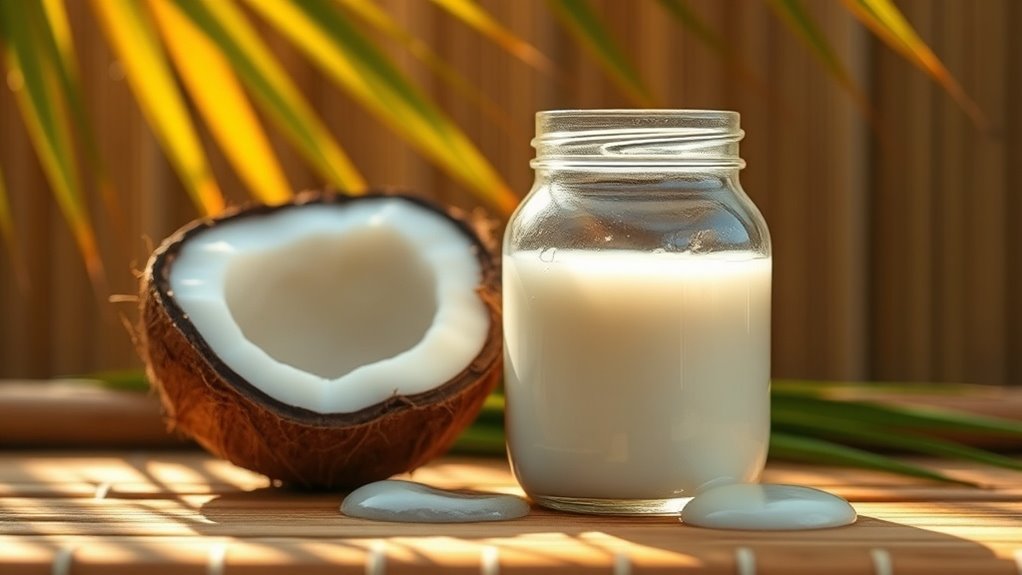Coconut Oil for Cuts and Skin- What Works Best for Me
Why I Started Using Coconut Oil for Healing
Three key factors led me to explore coconut oil for wound healing.
First, I discovered research showing coconut oil’s antimicrobial properties that help prevent infection.
Second, studies indicated its anti-inflammatory effects could reduce swelling and redness.
Third, my growing concern about synthetic ingredients in commercial products pushed me to seek natural alternatives for skin healing and repair. Additionally, I learned that regular consumption of coconut oil can boost immune system function, further supporting the healing process.
The Science Behind Coconut Oil’s Healing Properties
The scientific evidence supporting coconut oil’s healing abilities centers on its unique molecular composition.
Medium-chain fatty acids, particularly lauric acid, make up nearly 50% of coconut oil’s structure. These compounds possess antimicrobial properties that combat harmful bacteria.
Additionally, coconut oil contains vitamin E and polyphenols that reduce inflammation and promote skin cell regeneration, accelerating the natural healing process. Furthermore, the presence of medium-chain triglycerides (MCTs) makes coconut oil a quick source of energy and enhances metabolic support.
My Step-by-Step Application Process
To apply coconut oil effectively on cuts and skin, you’ll need to start with thoroughly cleaned and dried skin to prevent trapping bacteria. You should use gentle, circular motions to apply a thin layer of coconut oil directly to the affected area, ensuring complete coverage without oversaturation. For optimal results, you’ll want to apply the oil 2-3 times daily, particularly after washing and before bedtime, allowing the skin to absorb the oil between applications. Additionally, its natural antibacterial properties make coconut oil an excellent choice for promoting healing and preventing infections.
Clean Skin First
Before applying coconut oil to any skin injury, properly cleansing the affected area is essential for preventing bacterial contamination and optimizing healing outcomes.
Use mild soap and lukewarm water to gently clean the wound.
Pat the area dry with a clean, lint-free cloth or sterile gauze.
Don’t rub the skin, as this can cause irritation and disrupt the healing process.
Daily Application Tips
Following a consistent application routine maximizes coconut oil’s healing benefits for cuts and skin injuries.
| Step | Action |
|---|---|
| 1 | Apply a thin layer twice daily using clean fingertips |
| 2 | Gently massage in circular motions until absorbed |
| 3 | Cover with sterile gauze if needed |
For deep cuts, you’ll want to reapply every 4-6 hours during initial healing. Maintain this schedule until your wound shows clear signs of improvement.
Best Types of Coconut Oil for Wound Care
When selecting coconut oil for wound care, virgin or extra virgin varieties offer the highest concentrations of beneficial compounds.
These unrefined oils contain maximum levels of lauric acid and antioxidants, which support healing. Choose organic, cold-pressed options to ensure purity and avoid chemical residues. Consistent use can strengthen skin resilience against stressors and promote overall skin health.
You’ll want to store your coconut oil in a clean, sealed container away from direct sunlight and heat.
Results and Recovery Timeline
The application of high-quality coconut oil typically yields visible healing improvements within 2-3 days. You’ll notice reduced redness and inflammation during the first 48 hours. Minor cuts usually heal completely within 5-7 days, while deeper wounds may take 2-3 weeks. Consistent twice-daily applications support optimal recovery and minimize scarring. Monitor for signs of infection during the healing process. Additionally, coconut oil’s antimicrobial properties can further aid in preventing infection and promoting healing.
Additional Skin Benefits I’ve Discovered
You’ll find coconut oil effective at addressing dry, itchy patches of skin through its deep moisturizing properties and anti-inflammatory compounds.
The natural acids in coconut oil can help minimize the appearance of dark age spots when applied consistently over time.
When it comes to minor bug bites, coconut oil’s antimicrobial and soothing qualities provide relief while supporting the skin’s natural healing process.
Fights Dry Itchy Patches
Daily application of coconut oil provides remarkable relief for dry, itchy skin patches through its unique combination of medium-chain fatty acids and natural moisturizing properties.
You’ll find the oil’s lauric acid content helps reduce inflammation while creating a protective barrier that locks in moisture.
When you massage it into affected areas twice daily, it penetrates deeply to soothe irritation and restore your skin’s natural balance, preventing future flare-ups.
Minimizes Dark Age Spots
Beyond soothing dry patches, coconut oil demonstrates remarkable effectiveness in reducing dark age spots through its potent antioxidant properties.
Its active compounds, particularly vitamin E and ferulic acid, help inhibit melanin production while promoting cell turnover. You’ll notice gradual fading of age spots when you apply virgin coconut oil twice daily, especially on sun-damaged areas of your face and hands.
Soothes Minor Bug Bites
When mosquitoes, ants, or other insects leave you with irritating bites, coconut oil’s natural anti-inflammatory properties provide quick relief.
The oil’s lauric acid and capric acid components help reduce swelling, redness, and itching. Simply dab a small amount directly onto affected areas.
You’ll notice decreased discomfort within minutes as the oil’s antimicrobial properties also protect against potential infection from scratching.
